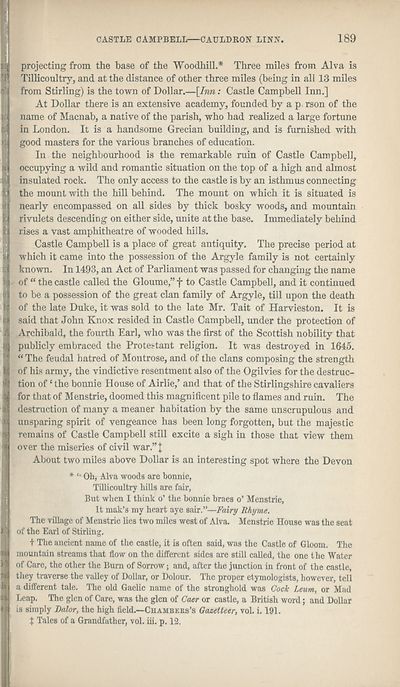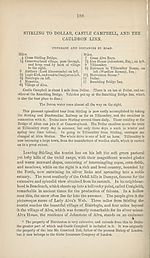Download files
Complete book:
Individual page:
Thumbnail gallery: Grid view | List view

CASTLE CAMPBELL—CAULDRON LINN.
projecting from the base of the Wbodhill.* Three miles from Alva is
Tillicoultry, and at the distance of other three miles (being in all 13 miles
from Stirling) is the town of Dollar.—[Inn: Castle Campbell Inn.]
At Dollar there is an extensive academy, founded by a p. rson of the
name of Macnab, a native of the parish, who had realized a large fortune
in London. It is a handsome Grecian building, and is furnished with
good masters for the various branches of education.
In the neighbourhood is the remarkable ruin of Castle Campbell,
occupying a wild and romantic situation on the top of a high and almost
insulated rock. The only access to the castle is by an isthmus connecting
the mount with the hill behind. The mount on which it is situated is
nearly encompassed on all sides by thick bosky woods, and mountain
rivulets descending on either side, unite at the base. Immediately behind
rises a vast amphitheatre of wooded hills.
Castle Campbell is a place of great antiquity. The precise period at
which it came into the possession of the Argyle family is not certainly
known. In 1493, an Act of Parliament was passed for changing the name
- of “ the castle called the Gloume,” f to Castle Campbell, and it continued
to be a possession of the great clan family of Argyle, till upon the death
of the late Duke, it was sold to the late Mr. Tait of Harvieston. It is
said that John Knox resided in Castle Campbell, under the protection of
.Archibald, the fourth Earl, who was the first of the Scottish nobility that
' publicly embraced the Protestant religion. It was destroyed in 1645.
“The feudal hatred of Montrose, and of the clans composing the strength
f of his army, the vindictive resentment also of the Ogilvies for the destruc¬
tion of ‘ the bonnie House of Airlie,’ and that of the Stirlingshire cavaliers
for that of Menstrie, doomed this magnificent pile to flames and ruin. The
destruction of many a meaner habitation by the same unscrupulous and
unsparing spirit of vengeance has been long forgotten, but the majestic
remains of Castle Campbell still excite a sigh in those that view them
over the miseries of civil war.”]
About two miles above Dollar is an interesting spot where the Devon
* “ Oh, Alva woods are bonnie,
Tillicoultry hills are fair,
But when I think o’ the bonnie braes o’ Menstrie,
It mak’s my heart aye sair.”—Fairy Rhyme.
The village of Menstrie lies two miles west of Alva. Menstrie House was the seat
of the Earl of Stirling.
t The ancient name of the castle, it is often said, was the Castle of Gloom. The
mountain streams that flow on the different sides are still called, the one the Water
of Care, the other the Burn of Sorrow; and, after the junction in front of the castle,
they traverse the valley of Dollar, or Dolour. The proper etymologists, however, tell
a different tale. The old Gaelic name of the stronghold was Cock Leum, or Mad
Leap. The glen of Care, was the glen of Coer or castle, a British word; and Dollar
is simply Dalor, the high field.—Chambeks’s Gazetteer, vol. i. 191.
t Tales of a Grandfather, vol. iii. p. 12.
projecting from the base of the Wbodhill.* Three miles from Alva is
Tillicoultry, and at the distance of other three miles (being in all 13 miles
from Stirling) is the town of Dollar.—[Inn: Castle Campbell Inn.]
At Dollar there is an extensive academy, founded by a p. rson of the
name of Macnab, a native of the parish, who had realized a large fortune
in London. It is a handsome Grecian building, and is furnished with
good masters for the various branches of education.
In the neighbourhood is the remarkable ruin of Castle Campbell,
occupying a wild and romantic situation on the top of a high and almost
insulated rock. The only access to the castle is by an isthmus connecting
the mount with the hill behind. The mount on which it is situated is
nearly encompassed on all sides by thick bosky woods, and mountain
rivulets descending on either side, unite at the base. Immediately behind
rises a vast amphitheatre of wooded hills.
Castle Campbell is a place of great antiquity. The precise period at
which it came into the possession of the Argyle family is not certainly
known. In 1493, an Act of Parliament was passed for changing the name
- of “ the castle called the Gloume,” f to Castle Campbell, and it continued
to be a possession of the great clan family of Argyle, till upon the death
of the late Duke, it was sold to the late Mr. Tait of Harvieston. It is
said that John Knox resided in Castle Campbell, under the protection of
.Archibald, the fourth Earl, who was the first of the Scottish nobility that
' publicly embraced the Protestant religion. It was destroyed in 1645.
“The feudal hatred of Montrose, and of the clans composing the strength
f of his army, the vindictive resentment also of the Ogilvies for the destruc¬
tion of ‘ the bonnie House of Airlie,’ and that of the Stirlingshire cavaliers
for that of Menstrie, doomed this magnificent pile to flames and ruin. The
destruction of many a meaner habitation by the same unscrupulous and
unsparing spirit of vengeance has been long forgotten, but the majestic
remains of Castle Campbell still excite a sigh in those that view them
over the miseries of civil war.”]
About two miles above Dollar is an interesting spot where the Devon
* “ Oh, Alva woods are bonnie,
Tillicoultry hills are fair,
But when I think o’ the bonnie braes o’ Menstrie,
It mak’s my heart aye sair.”—Fairy Rhyme.
The village of Menstrie lies two miles west of Alva. Menstrie House was the seat
of the Earl of Stirling.
t The ancient name of the castle, it is often said, was the Castle of Gloom. The
mountain streams that flow on the different sides are still called, the one the Water
of Care, the other the Burn of Sorrow; and, after the junction in front of the castle,
they traverse the valley of Dollar, or Dolour. The proper etymologists, however, tell
a different tale. The old Gaelic name of the stronghold was Cock Leum, or Mad
Leap. The glen of Care, was the glen of Coer or castle, a British word; and Dollar
is simply Dalor, the high field.—Chambeks’s Gazetteer, vol. i. 191.
t Tales of a Grandfather, vol. iii. p. 12.
Set display mode to:
![]() Universal Viewer |
Universal Viewer | ![]() Mirador |
Large image | Transcription
Mirador |
Large image | Transcription
| Antiquarian books of Scotland > Scotland/Scots > Black's picturesque tourist of Scotland > (269) |
|---|
| Permanent URL | https://digital.nls.uk/130031418 |
|---|
| Description | Thousands of printed books from the Antiquarian Books of Scotland collection which dates from 1641 to the 1980s. The collection consists of 14,800 books which were published in Scotland or have a Scottish connection, e.g. through the author, printer or owner. Subjects covered include sport, education, diseases, adventure, occupations, Jacobites, politics and religion. Among the 29 languages represented are English, Gaelic, Italian, French, Russian and Swedish. |
|---|

